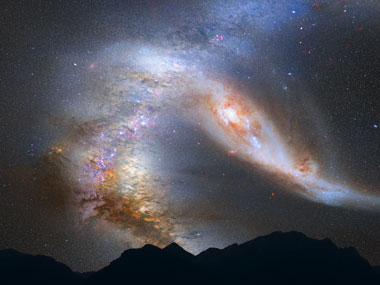Want to know when the world will end? Well NASA has done all the maths required for that. The answer: the entire Milky Way galaxy will crash into the neighbouring Andromeda galaxy with a head-on hit — in 4 billion years. Earth however might just survive the space-collision with a few minor changes in the night time view. Astronomers made the announcement on Thursday at a NASA news conference. So how exactly will Andromeda smash into our beloved _Aakash Ganga (_Milky Way)? Well according to NASA experts, about 3.75 billion years from now, Andromeda’s disk will fill the field of view and its gravity will begin to create tidal distortions in the Milky Way. This crash was sort of anticipated, but astronomers thought there was a chance that its sideways motion would make it miss or graze the Milky Way. However the latest observations from the Hubble Space Telescope dismissed all hope of a lucky miss. Hubble readings say that its definitely happening. Scientists say the sun and Earth should easily survive what will be a 1.2 million mile per hour (1.9 million kph) galactic merger, but likely will be in a different place in the cosmos. [caption id=“attachment_328875” align=“alignleft” width=“380” caption=“This illustration released by NASA depicts a view of the night sky just before the predicted merger between our Milky Way galaxy, left, and the neighboring Andromeda galaxy. AP”]
 [/caption] According to
RT.com
, “The Andromeda galaxy is heading straight in our direction,” Roeland van der Marel, an astronomer with the Space Telescope Science Institute in Baltimore, which operates Hubble, told the media. “The galaxies will collide, and they will merge together to form one new galaxy.” So what will the new galaxy be shaped like? An elliptical shape than barred spiral, which is how Milky Way is currently shaped. The night-view on Earth is also likely to undergo a massive change and the Andromeda Galaxy will dominate the skies after the smash. The only way Andromeda could miss colliding with the Milky Way is if it were moving sideways about six times faster than Hubble indicates it is, said van der Marel, who is publishing the latest findings in an upcoming issue of Astrophysical Journal. Five years ago, Avi Loeb, head of Harvard University’s astronomy department, simulated this crash and pronounced a miss unlikely. He said the Hubble results strengthen his earlier findings. He calls the newly merged galaxy “Milkomeda.” Both the Milky Way and Andromeda are about the same size and same age — 10 billion years old. At times they’ve been considered virtual twins so it’s hard to tell which of the galaxies will get the worst of the collision, van der Marel said. With inputs from Associated Press
[/caption] According to
RT.com
, “The Andromeda galaxy is heading straight in our direction,” Roeland van der Marel, an astronomer with the Space Telescope Science Institute in Baltimore, which operates Hubble, told the media. “The galaxies will collide, and they will merge together to form one new galaxy.” So what will the new galaxy be shaped like? An elliptical shape than barred spiral, which is how Milky Way is currently shaped. The night-view on Earth is also likely to undergo a massive change and the Andromeda Galaxy will dominate the skies after the smash. The only way Andromeda could miss colliding with the Milky Way is if it were moving sideways about six times faster than Hubble indicates it is, said van der Marel, who is publishing the latest findings in an upcoming issue of Astrophysical Journal. Five years ago, Avi Loeb, head of Harvard University’s astronomy department, simulated this crash and pronounced a miss unlikely. He said the Hubble results strengthen his earlier findings. He calls the newly merged galaxy “Milkomeda.” Both the Milky Way and Andromeda are about the same size and same age — 10 billion years old. At times they’ve been considered virtual twins so it’s hard to tell which of the galaxies will get the worst of the collision, van der Marel said. With inputs from Associated Press
Cosmic-crash: Milky Way will smash into Andromeda galaxy
FP Staff
• June 1, 2012, 13:43:39 IST
Want to know when the world will end? Well NASA has done all the maths required for that. The answer: the entire Milky Way galaxy will crash into the neighbouring Andromeda galaxy with a head-on hit — in 4 billion years.
Advertisement
)
End of Article